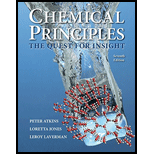
(a)
Interpretation:
The aqueous solution of potassium oxalate salt is neutral pH or greater than 7 or less than 7 has to be determined.
Aqueous solution of salt:
The salt is added in water, it will dissolved and generate
Neutral solution:
For the neutral solution, the pH is at 7. In periodic table, group 1 and 2 elements and from other groups those who have +1 charge cations are weak Lewis acids, these hydrated ions does not affect the protons from water. As well as these metal cations are very big, otherwise they may have very small charge to hydrating water molecules to get appreciable polarization effect. These types of cations are called neutral cations because they may not affect the pH of the solution.
The anions from strong acids like halides (except F), nitrates, perchlorates are such weak Lewis bases, so they may not affect the pH of the solution. These anions are called neutral in water.
Acidic solution:
The conjugate acids of weak bases cations make the solution acidic in aqueous medium, because it acts as proton donors. In another case, the metal cations with high charge can act as Lewis acids in aqueous medium solution, even though the cations do not have protons to donate.
Basic solution:
The conjugate bases of weak acids anions make the solution basic in aqueous medium, here, the protons leaves from the negatively charged anions.
(b)
Interpretation:
The aqueous solution of calcium nitrate salt is neutral pH or greater than 7 or less than 7 has to be determined.
Concept introduction:
Refer to part (a).
(c)
Interpretation:
The aqueous solution of methylammonium hydrochloride salt is neutral pH or greater than 7 or less than 7 has to be determined.
Concept introduction:
Refer to part (a).
(d)
Interpretation:
The aqueous solution of potassium phosphate salt is neutral pH or greater than 7 or less than 7 has to be determined.
Concept introduction:
Refer to part (a).
(e)
Interpretation:
The aqueous solution of ferric chloride salt is neutral pH or greater than 7 or less than 7 has to be determined.
Concept introduction:
Refer to part (a).
(f)
Interpretation:
The aqueous solution of pyridinium chloride salt is neutral pH or greater than 7 or less than 7 has to be determined.
Concept introduction:
Refer to part (a).
Want to see the full answer?
Check out a sample textbook solution
Chapter 6 Solutions
Chemical Principles: The Quest for Insight
- I need help with the followingarrow_forwardFor Raman spectroscopy/imaging, which statement is not true regarding its disadvantages? a) Limited spatial resolution. b) Short integration time. c) A one-dimensional technique. d) Weak signal, only 1 in 108 incident photons is Raman scattered. e) Fluorescence interference.arrow_forwardUsing a cell of known pathlength b = 1.25115 x 10-3 cm, a water absorption spectrum was measured. The band at 1645 cm-1, assigned to the O-H bending, showed an absorbance, A, of 1.40. a) Assuming that water density is 1.00 g/mL, calculate the water molar concentration c (hint: M= mole/L) b) Calculate the molar absorptivity, a, of the 1645 cm-1 band c) The transmitted light, I, can be written as I= Ioexp(-xb), where x is the absorption coefficient (sometimes designated as alpha), Io is the input light, and b is the cell pathlength. Prove that x= (ln10)*x*c. (Please provide a full derivation of the equation for x from the equation for I). d) Calculate x for the 1645 cm-1 bandarrow_forward
- For CARS, which statement is not true regarding its advantages? a) Contrast signal based on vibrational characteristics, no need for fluorescent tagging. b) Stronger signals than spontaneous Raman. c) Suffers from fluorescence interference, because CARS signal is at high frequency. d) Faster, more efficient imaging for real-time analysis. e) Higher resolution than spontaneous Raman microscopy.arrow_forwardDraw the major product of the Claisen condensation reaction between two molecules of this ester. Ignore inorganic byproducts. Incorrect, 5 attempts remaining 1. NaOCH3/CH3OH 2. Acidic workup Select to Draw O Incorrect, 5 attempts remaining The total number of carbons in the parent chain is incorrect. Review the reaction conditions including starting materials and/or intermediate structures and recount the number of carbon atoms in the parent chain of your structure. OKarrow_forwardUsing a cell of known pathlength b = 1.25115 x 10-3 cm, a water absorption spectrum was measured. The band at 1645 cm-1, assigned to the O-H bending, showed an absorbance, A, of 1.40. a) Assuming that water density is 1.00 g/mL, calculate the water molar concentration c (hint: M= mole/L) b) Calculate the molar absorptivity, a, of the 1645 cm-1 band c) The transmitted light, I, can be written as I= Ioexp(-xb), where x is the absorption coefficient (sometimes designated as alpha), Io is the input light, and b is the cell pathlength. Prove that x= (ln10)*x*c d) Calculate x for the 1645 cm-1 bandarrow_forward
 Chemistry: Principles and PracticeChemistryISBN:9780534420123Author:Daniel L. Reger, Scott R. Goode, David W. Ball, Edward MercerPublisher:Cengage Learning
Chemistry: Principles and PracticeChemistryISBN:9780534420123Author:Daniel L. Reger, Scott R. Goode, David W. Ball, Edward MercerPublisher:Cengage Learning Chemistry: The Molecular ScienceChemistryISBN:9781285199047Author:John W. Moore, Conrad L. StanitskiPublisher:Cengage Learning
Chemistry: The Molecular ScienceChemistryISBN:9781285199047Author:John W. Moore, Conrad L. StanitskiPublisher:Cengage Learning Principles of Modern ChemistryChemistryISBN:9781305079113Author:David W. Oxtoby, H. Pat Gillis, Laurie J. ButlerPublisher:Cengage Learning
Principles of Modern ChemistryChemistryISBN:9781305079113Author:David W. Oxtoby, H. Pat Gillis, Laurie J. ButlerPublisher:Cengage Learning Chemistry & Chemical ReactivityChemistryISBN:9781337399074Author:John C. Kotz, Paul M. Treichel, John Townsend, David TreichelPublisher:Cengage Learning
Chemistry & Chemical ReactivityChemistryISBN:9781337399074Author:John C. Kotz, Paul M. Treichel, John Townsend, David TreichelPublisher:Cengage Learning Chemistry & Chemical ReactivityChemistryISBN:9781133949640Author:John C. Kotz, Paul M. Treichel, John Townsend, David TreichelPublisher:Cengage Learning
Chemistry & Chemical ReactivityChemistryISBN:9781133949640Author:John C. Kotz, Paul M. Treichel, John Townsend, David TreichelPublisher:Cengage Learning Chemistry by OpenStax (2015-05-04)ChemistryISBN:9781938168390Author:Klaus Theopold, Richard H Langley, Paul Flowers, William R. Robinson, Mark BlaserPublisher:OpenStax
Chemistry by OpenStax (2015-05-04)ChemistryISBN:9781938168390Author:Klaus Theopold, Richard H Langley, Paul Flowers, William R. Robinson, Mark BlaserPublisher:OpenStax





